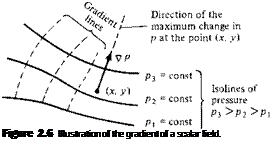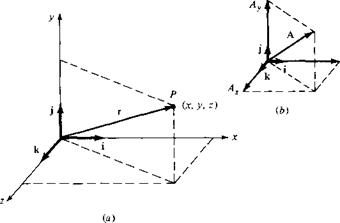Typical Orthogonal Coordinate Systems
To describe mathematically the flow of fluid through three-dimensional space, we have to prescribe a three-dimensional coordinate system. The geometry of some aerodynamic problems best fits a rectangular space, whereas others are mainly cylindrical in nature, and yet others may have spherical properties. Therefore, we have interest in the three most common orthogonal coordinate systems: cartesian, cylindrical, and spherical. These systems are described below. (An orthogonal coordinate system is one where all three coordinate directions are mutually perpendicular. It is interesting to note that some modem numerical solutions of fluid flows utilize nonorthogonal coordinate spaces; moreover, for some numerical problems the coordinate system is allowed to evolve and change during the course of the solution. These so-called adaptive grid techniques are beyond the scope of this book. See Reference 7 for details.)
A cartesian coordinate system is shown in Figure 23a. The x, y, and z axes are mutually perpendicular, and i, j, and к are unit vectors in the x, y, and z directions, respectively. An arbitrary point P in space is located by specifying the three coordinates (x, y, z). The point can also be located by the position vector r, where
г = XI + yj + zk
If A is a given vector in cartesian space, it can be expressed as
A = Axi + Ay j + Az к
where Ax, Ay, and Az are the scalar components of A along the x, y, and z directions, respectively, as shown in Figure 23b.
|
Figure 2.3 Cartesian coordinates. |
A cylindrical coordinate system is shown in Figure 2.4a. A “phantom” cartesian system is also shown with dashed lines to help visualize the figure. The location of point P in space is given by three coordinates (г, в, z), where r and в are measured in the xy plane shown in Figure 2.4a. The r coordinate direction is the direction of increasing r, holding в and z constant; er is the unit vector in the r direction. The в coordinate direction is the direction of increasing 0, holding r and z constant; eg is the unit vector in the 0 direction. The г coordinate direction is the direction of increasing z, holding r and 0 constant; e: is the unit vector in the z direction. If A is a given vector in cylindrical space, then
A = Arer + AgCt9 + Аге.
where Ar, Ag, and Az are the scalar components of A along the r, 0, and z directions, respectively, as shown in Figure 2Ab. The relationship, or transformation, between cartesian and cylindrical coordinates can be obtained from inspection of Figure 2.4a, namely,
x = r cos 0
у = r sin 0 [2.5]
г = z
or inversely,
r = y/x2 + y2
0 = arctan — [2.6]
JC
z = z
A spherical coordinate system is shown in Figure 2.5a. Once again, a phantom cartesian system is shown with dashed lines. (However, for clarity in the picture, the
 |
ia)
z axis is drawn vertically, in contrast to Figures 2.3 and 2.4.) The location of point P in space is given by the three coordinates (r, 0, Ф), where r is the distance of P from the origin, в is the angle measured from the z axis and is in the rz plane, and Ф is the angle measured from the x axis and is in the xy plane. The r coordinate direction is the direction of increasing r, holding в and Ф constant; e, is the unit vector in the r
direction. The в coordinate direction is the direction of increasing в, holding r and Ф constant; eg is the unit vector in the в direction. The Ф coordinate direction is the direction of increasing Ф, holding r and в constant; e<j> is the unit vector in the Ф direction. The unit vectors er, eg, and Єф are mutually perpendicular, if A is a given vector in spherical space, then
A = Are, + Agfig + АфЄф
where Ar, Ag, and Аф are the scalar components of A along the r,6, and Ф directions, respectively, as shown in Figure 2.5b. The transformation between cartesian and spherical coordinates is obtained from inspection of Figure 2.5a, namely,
x — r sin в cos Ф
у = r sin 9 sin Ф [2.7]
z = r cos в
or inversely,
r = /ї2 + y2 + z2
n z z r ,
0 = arccos – = arccos, [2.81
r 3/x2 + y2 + z2
X
Ф = arccos, :
2.2.2 Scalar and Vector Fields
A scalar quantity given as a function of coordinate space and time t is called a scalar field. For example, pressure, density, and temperature are scalar quantities, and
P – Pi(x, y, z, t) = p2(r, в, z, t) = p3(r, в, Ф, t) p = P(x, y, z, t) = p2(r, в, Z, t) = рз(r, в, Ф, t)
T = Ti(x, y, z, t) = T2(r, в, z, t) = Тз(г, в, Ф, t)
are scalar fields for pressure, density, and temperature, respectively. Similarly, a vector quantity given as a function of coordinate space and time is called a vector field. For example, velocity is a vector quantity, and
V = V, i + Vvj + V, k
where Vx = Vx(x, y, z, t)
V, = Vy(x, y,z, t)
Vz = Vz(x, y, z, t)
is the vector field for V in cartesian space. Analogous expressions can be written for vector fields in cylindrical and spherical space. In many theoretical aerodynamic problems, the above scalar and vector fields are the unknowns to be obtained in a solution for a flow with prescribed initial and boundary conditions.
2.2.3 Scalar and Vector Products
The scalar and vector products defined by Equations (2.3) and (2.4), respectively, can be written in terms of the components of each vector as follows.
Cartesian Coordinates Let
|
A = АдТ + Ay j + Azk
|
Cylindrical Coordinates Let
A = Arer + AgCg + Azez and В = Brtr + ВвЄд + B, ez
Then A • В = ArBr + AgBg + AZBZ [2.11]
|
er ee |
ег |
||||
|
and |
A x В = |
Ar Ад |
[2.12] |
||
|
В, Вд |
Bz |
||||
|
Spherical Coordinates Let |
|||||
|
A = Arer |
+ Адед + АфЄф |
||||
|
and |
В = Brer |
+ Bgtg + ВфЄф |
|||
|
Then |
A • В = ArBr + AqBq |
+ АфВф |
[2.13] |
||
|
Є, Єв |
Сф |
||||
|
and |
A x В = |
Аг Ад |
Аф |
[2.14] |
|
|
Вг Вд |
Вф |
2.2.4 Gradient of a Scalar Field
We now begin a review of some elements of vector calculus. Consider a scalar field
P = Pi(x, y, z) = рг(г, в, z) = рз(г, в, Ф)
The gradient of p, Vp, at a given point in space is defined as a vector such that:
0. Its magnitude is the maximum rate of change of p per unit length of the coordinate space at the given point.
1. Its direction is that of the maximum rate of change of p at the given point.
For example, consider a two-dimensional pressure field in cartesian space as sketched in Figure 2.6. The solid curves are lines of constant pressure; i. e., they connect points in the pressure field which have the same value of p. Such lines are called isolines. Consider an arbitrary point (jc, y) in Figure 2.6. If we move away from this point in an arbitrary direction, p will, in general, change because we are moving to another location in space. Moreover, there will be some direction from this point along which p changes the most over a unit length in that direction. This defines the direction of the gradient of p and is identified in Figure 2.6. The magnitude of Vp is the rate of change of p per unit length in that direction. Both the magnitude and direction of Vp will change from one point to another in the coordinate space. A line drawn in this space along which V/? is tangent at every point is defined as a gradient line, as sketched in Figure 2.6. The gradient line and isoline through any given point in the coordinate space are perpendicular.
Consider V/j at a given point (x, y) as shown in Figure 2.7. Choose some arbitrary direction s away from the point, as also shown in Figure 2.7. Let n be a unit vector in the s direction. The rate of change of p per unit length in the s direction is
![]()
 [2.15]
[2.15]
у
У
S
Figure 2.7 Sketch for the
directional derivative.












